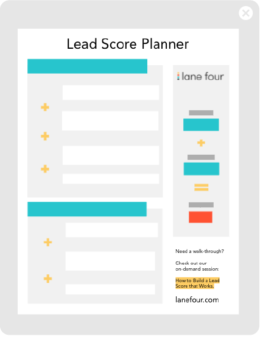SDR productivity can make or break your sales pipeline. In a high-growth environment, where frequent rep turnover is the reality, the pressure is even higher. What can you do in onboarding to help new SDRs learn habits that will make them successful in the long run?
When Lane Four’s SaaS Practice Manager Aidas Dirse was tasked with streamlining the SDR onboarding process for a high-growth company, he sat down with each new SDR and asked a simple question:
“What do you do in a day?”
To his surprise, many of the SDRs didn’t have a clear answer when asked to walk through their day. He found that, despite robust training, new SDRs were often confused about how to spend their time. They didn’t know where to start or how best to organize the technical resources available to them. As a result, these SDRs wasted hours a day overthinking their process.
In asking this simple question, Aidas and his team identified three things they could do right away to make onboarding faster and more effective. Focusing on the three areas that follow, Aidas’ company was able to cut onboarding time from 3 weeks down to 1, and get reps working more efficiently from the start.
#1 Teach Time Management
The phrase “time is money” rings especially true in the SDR world. Every minute an SDR spends on something other than selling risks business. It is crucial that incoming SDRs—particularly those who may be new to the workforce—are equipped with time management skills that will optimize their workdays and maximize their time with leads.
Teaching time management can be as simple as showing SDRs how to block out time in their personal calendars. Calendar blocking eliminates confusion about what the rep should be working on at any given time, and maximizes their efficiency.
Aidas emphasizes the importance of avoiding calendar gaps. Half-hour gaps between meetings add up quickly. They are too long to be rest breaks, but too short to be productive blocks. In the end, these 30 minute gaps will add up to hours of lost time.
#2 Consolidate the User Experience for SDRs
Walk through your current sales tech stack to see what the user experience is like for an SDR. How many different tools does the SDR need to log in to in order to do their job? How many tabs or windows need to be open? If the answer is more than 1 or 2 interfaces, consider consolidating.
To start, decide which tools are absolutely essential for onboarding. A good initial setup for many teams includes Salesforce, a sales engagement platform, and LinkedIn Sales Navigator. In addition to Salesforce integrations, consider implementing the Chrome extensions available for as many tools as possible. This will keep your SDRs’ attention focused in one place, eliminate time spent switching between tools, and make it easier to capture data efficiently.
#3 Teach Clear and Simple Daily Processes
Narrow parameters and clear processes will help your SDRs master the skills they need in order to be efficient going forward. In the beginning, you’ll want to get your reps doing two things right away: prospecting and reaching out to these prospects. Pared down processes for prospecting and reaching out will get your SDRs comfortable with the core responsibilities of their role while greatly reducing the possibility of wasted time.
Prospecting
Prospects are the fuel required to power the machine of an SDR’s work. So from day one, you need to get your SDRs prospecting efficiently. Once you’ve educated them on the basics of your ICP and the personas they are going after, it can work well to pre-build Salesforce reports specifically for new SDRs to prospect from. This removes guesswork and allows them to practice identifying the accounts and individuals they should be prospecting.
Reaching Out: Emails, Calls, and Social
Once your reps have the fuel (accounts and contacts), they can learn how to make the sales machine run. If you’re using a sales engagement tool like Outreach.io or Salesloft, creating pre-built sequences is the easiest way to get your new SDRs doing activities. Aidas and his team built a simple sequence that included a mix of touchpoints their reps needed to master, such as calls at various times of day, automatic and manual emails, LinkedIn messages, and more. Rather than worrying about the nitty gritty of message frequency or personalization, the goal at this stage is to get reps doing activities, and appreciating how sequences/cadences will organize their day.
You Don’t Have to Keep Your SDRs “Inside the Box” Forever
If the above suggestions feel restrictive, that’s because they’re designed to be. Establishing clear and simple processes during onboarding means laying the groundwork for future success. But your SDRs don’t have to—and shouldn’t—stay inside the box forever.
If you follow some or all of these tips, you’ll provide new SDRs with fundamental skills that grow their confidence, and set the stage for becoming more creative and free as they start to ramp up. Plus, the faster new SDRs become comfortable with fundamental processes, the faster the team can scale.
Next week, we’ll be talking about how to introduce other valuable tools form your tech stack to the SDR workflow, plus more tips to improve ramping.

